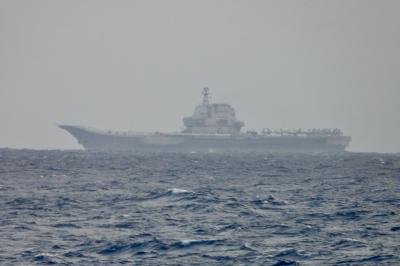The Philippines is to station new fighter jets and two frigates at the former US naval facility in Subic Bay from early next year, officials said, the first time the massive installation has functioned as a military base in 23 years.
Using Subic Bay would allow the Philippine air force and navy to respond more effectively to Chinese moves in the disputed South China Sea, security experts said.
Subic Bay’s deep-water harbor lies on the western side of the main Philippine island of Luzon, opposite the South China Sea.
“The value of Subic as a military base was proven by the Americans. Chinese defense planners know that,” said Rommel Banlaoi, a Philippine security expert.
Once one of the biggest US naval facilities in the world, Subic Bay was shut in 1992 after the Philippine Senate terminated a bases agreement with Washington at the end of the Cold War.
Manila converted the facility, which was never home to the Philippine military, into an economic zone.
Philippine Undersecretary of Defense Pio Lorenzo Batino said the Philippine military signed an agreement in May with the zone’s operator, the Subic Bay Metropolitan Authority, to use parts of the installation under a renewable 15-year lease.
US warships have called regularly at Subic Bay since 2000, but only to dock during exercises with the Philippine military or to use its commercial facilities for repairs and resupply.
Officials said once Subic Bay is a military base again, the US Navy could have much greater access.
China, which claims nearly all of the South China Sea, said it was aware of reports.
“We hope that the Philippines does more to benefit regional peace and stability,” the Chinese Ministry of National Defense said in a faxed statement.
Beijing also hit out at Manila for repairing a crumbling ship serving as its outpost in the South China Sea, branding the Philippines a “hypocritical troublemaker and rule breaker.”
The Philippine military deliberately grounded the 100m World War II-vintage BRP Sierra Madre on top of the Second Thomas Shoal (Renai Shoal, 仁愛暗) in 1999 in an effort to check the advance of China, which four years earlier occupied Mischief Reef (Meiji Reef, 美濟礁) about 40km away.
Philippine Navy spokesman Colonel Edgard Arevalo said on Wednesday that the vessel was being repaired to ensure the ship remains livable for a unit of marines guarding the reefs.
The move drew a vehement protest from Beijing, with Chinese Ministry of Foreign Affairs spokeswoman Hua Chunying (華春瑩) accusing Manila of attempting to “permanently steal” the outcrops, while insisting that all of the Spratly Islands (Nansha Islands, 南沙群島) are Chinese territory. Some or all of the islands are claimed by Taiwan, China, the Philippines, Vietnam, Brunei and Malaysia.
“China strongly protests and firmly opposes such an act,” Hua said in a statement on Wednesday.
She also argued that Manila had gone back on its word by repeatedly promising to remove the ship — a claim the Philippines denies.
“The relevant activity fully exposed the Philippines’ hypocrisy and that it is a double dealer,” Hua said. “It once again proved that the Philippines is truly a troublemaker and rule breaker in the region.”

AIR SUPPORT: The Ministry of National Defense thanked the US for the delivery, adding that it was an indicator of the White House’s commitment to the Taiwan Relations Act Deputy Minister of National Defense Po Horng-huei (柏鴻輝) and Representative to the US Alexander Yui on Friday attended a delivery ceremony for the first of Taiwan’s long-awaited 66 F-16C/D Block 70 jets at a Lockheed Martin Corp factory in Greenville, South Carolina. “We are so proud to be the global home of the F-16 and to support Taiwan’s air defense capabilities,” US Representative William Timmons wrote on X, alongside a photograph of Taiwanese and US officials at the event. The F-16C/D Block 70 jets Taiwan ordered have the same capabilities as aircraft that had been upgraded to F-16Vs. The batch of Lockheed Martin

GRIDLOCK: The National Fire Agency’s Special Search and Rescue team is on standby to travel to the countries to help out with the rescue effort A powerful earthquake rocked Myanmar and neighboring Thailand yesterday, killing at least three people in Bangkok and burying dozens when a high-rise building under construction collapsed. Footage shared on social media from Myanmar’s second-largest city showed widespread destruction, raising fears that many were trapped under the rubble or killed. The magnitude 7.7 earthquake, with an epicenter near Mandalay in Myanmar, struck at midday and was followed by a strong magnitude 6.4 aftershock. The extent of death, injury and destruction — especially in Myanmar, which is embroiled in a civil war and where information is tightly controlled at the best of times —

China's military today said it began joint army, navy and rocket force exercises around Taiwan to "serve as a stern warning and powerful deterrent against Taiwanese independence," calling President William Lai (賴清德) a "parasite." The exercises come after Lai called Beijing a "foreign hostile force" last month. More than 10 Chinese military ships approached close to Taiwan's 24 nautical mile (44.4km) contiguous zone this morning and Taiwan sent its own warships to respond, two senior Taiwanese officials said. Taiwan has not yet detected any live fire by the Chinese military so far, one of the officials said. The drills took place after US Secretary

THUGGISH BEHAVIOR: Encouraging people to report independence supporters is another intimidation tactic that threatens cross-strait peace, the state department said China setting up an online system for reporting “Taiwanese independence” advocates is an “irresponsible and reprehensible” act, a US government spokesperson said on Friday. “China’s call for private individuals to report on alleged ‘persecution or suppression’ by supposed ‘Taiwan independence henchmen and accomplices’ is irresponsible and reprehensible,” an unnamed US Department of State spokesperson told the Central News Agency in an e-mail. The move is part of Beijing’s “intimidation campaign” against Taiwan and its supporters, and is “threatening free speech around the world, destabilizing the Indo-Pacific region, and deliberately eroding the cross-strait status quo,” the spokesperson said. The Chinese Communist Party’s “threats